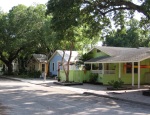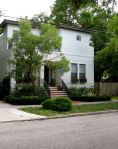Here is an update to the “Form-based code post I wrote last year………… It is a recent article by Robert Steuteville, Better Cities and Towns that is worth adding to the original post- Form-based codes offer predictability.
__________________________________________________________
The City of Sarasota is finally working to update and improve the existing zoning code. To accomplish this, they are looking to use form-based code. The Urban Design Studio, a newly formed department in the City of Sarasota has been charged with the task. This modernization of Sarasota’s code can have positive effects on the future development of the Laurel Park National Register Historic District and the entire area known as Laurel Park, currently zoned RSM-9.
So what is Form-Based Code?
The Urban Design Studio defines it as:
A form-based code (FBC) and its districts are different than conventional zoning. Conventional zoning designates permitted uses of land based on mapped zones which separate one set of land uses from another, and while it separates uses it is difficult to determine what the built environment or community will look like upon build out. A Form-based code fosters predict-able buildings and high-quality public spaces by using physical form (rather than separation of uses) as the organizing principle for the code. The zone districts or Transects are regulations, not mere guidelines, adopted into city or county law. Form-based codes address the relationship between building facades and public spaces such as parks, the form and mass of buildings in relation to one another, and the scale and types of streets and blocks. The regulations and standards in form-based codes are presented in words and clearly drawn diagrams, metrics and other graphics.
Interestingly, in 2007 Sarasota County Commissioners voted to add form-based code to the county’s zoning as an option for mixed-use and commercial development. According to Sarasota County’s website:
-
buildings and pedestrians to the public realm,
-
the form and mass of buildings in relation to one another,
-
the scale and network of streets and blocks.
Old Sanborn Map – portion of today’s Laurel Park
In older neighborhoods such as Laurel Park where the history of development spans decades with no one code applied throughout, the flexibility of form-based code makes terrific sense.
Laurel Park is a neighborhood where:
- setbacks vary from property to property
- architectural styles are diverse
- portions of the neighborhood lie in a flood zone
- there are a variety of sidewalk, curb, apron, and street types
- rights-of-ways vary
There is a wealth of information to quickly understand how form-based code works and can be applied. The Form-Based Codes Institute is an obvious and a tremendous resource for information:
- Form-Based Codes Defined
- Bill Spikowski’s Video – “Creating Urban Form”
- Form-Based Codes: A Step by Step Guide for Communities
- FBCI Library of Codes
- An online course with instructor feedback
- Webinars
More information is available in these articles:
Dialing-in your zoning to fit your community by Tony Perez
Why design guidelines on their own don’t work by Kaizer Rangwala
Form-based codes – new approach to zoning published by Smart Growth Tactics
Finding the right path through design review by Kaizer Rangwala
Ways to fail at form-based codes: Don’t articulate a vision by Hazel Borys







